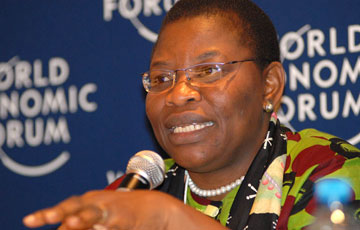
By The Independent Team
‘A strong position has to be taken on corruption and efficiency of local government in the delivery of services’
According to the International Monetary Fund (IMF) Uganda`s real economic growth is projected at6.0 percent in 2010, higher than that of many other comparable countries.
The projection is premised on Uganda’s sustained macroeconomic policies, a flexible labour market and access to international markets in spite of the slow World recovery from tha global financial meltdown .
Uganda`s economic growth according to the IMF World economic outlook 2009 is expected to recover to a longer-term average of 7.0% by 2012. However the IMF Uganda Representative Tom Richardson told Reuters in an interview that any instability in Congo or south Sudan could hurt the Ugandan economy
Trade

The IMF expects Uganda’s trade deficit, the difference between imports and exports, to fall to 7.8 percent of its gross domestic product (GDP) in 2010 from 8.2 percent in 2009.
By year 2009 end foreign investors were returning to Uganda’s fixed income and currency markets which they exited in late 2008 as a result of the global financial meltdown.
External shocks
Uganda’s central bank says the economy ventures into 2010 against a backdrop of three successive external shocks; the very steep rise in international commodity and food prices, which peaked in mid 2008, drove up inflation in Uganda in the fiscal year 2008/09; the most severe recession in more than 50 years as manifested by the financial crisis in the advanced economies that resulted shortly after international commodity prices peaked; and on the domestic scene, the economy was also hit temporarily by the drought experienced in the period July 2009-September 2009.
The Ugandan economy, however, ably adjusted to the external shocks through the Balance of payments and the flexible exchange rate that partly absorbed the shock. Monetary policy management by Bank of Uganda (BOU) has recently been further complicated by the weakening of aggregate demand in the economy, as exemplified by lower net exports, slowed growth in private sector credit and lower demand for currency.
Online trading
Online trading of corporate bonds has taken root on the NSE in Kenya. This is based on the Central Depository System(CDS) platform and will probably take place on the USE in Uganda as well during 2010. There has been a confusion of online trading with automated trading. Automated trading is yet to take place. Automated trading is where a mathematical model is rigged with parameters that trigger a “sale” or “buy” instruction of a security once threshold levels are reached. There are many who believe that because of the elections of 2011 approaching we should expect to see more growth in money supply and therefore inflation. “I do not expect the approach of the elections to lead to sudden inflation” says Mutimba. Stanbic Bank Investiment Manager. The recent inflation we have seen at 14.5% was the highest since 2002 . The bigger threat to inflation could be a rise in global oil prices, leading to higher transport and production costs in Uganda.
Oil

Investor interest in Uganda`s discovered oil sector is also heating up. Uganda`s financial markets are projected to grow in spite of the bearish trend the equities market took right after the global financial meltdown set in. The stocks began picking up towards the end of 2009 and sector players are predicting a rejuvenated market in 2010.
Monetary policy
In response, BoU says, its conduct of monetary policy has been attuned to focus on providing liquidity to the financial system in an effort to support aggregate demand in the economy in the first half of 2009/10. This was, however, done without losing sight of the overall price stability objective.
As a result, BoU says, annual core inflation, which peaked at 13.7 percent in August 2008, remains on course towards its long-term target of about 5 percent, standing at 8.8 percent in November 2009.
Reasonable flexibility was also introduced in September 2009, to the implementation of the monetary targeting framework, with a clear distinction between structural (long-term) liquidity and short-term liquidity needs of the economy. In an effort to further ease the monetary policy stance and also to foster stability in the BOU rates, the margin within the rediscount rate was reduced from 6.7 to 3.4 percentage points in March 2009, and subsequently, further down to 3.0 percentage points in September 2009.

The exchange rate remains market determined in line with the liberilised current and capital accounts. However in the interim period, BOU will intervene to support aggregate demand and economic growth.
BoU says, in the meantime, the international reserves built up since the 1990s, and amounting to US$ 2.8 billion by end October 2009, shall continue to provide a large buffer of resources to maintain investor confidence and support the balance of payments. The robust regional demand for Uganda’s produce, mainly food and industrial products shall also continue to provide a vital safeguard for the country’s external trade profile.
The successful implementation of the 2009/10 budget is also expected to lead to improved productivity and private sector competitiveness, especially in the medium term.
Capital markets

Simon Rutega the Chief executive at the Uganda securities Exchange(USE) says, “the economy will continue to grow at about 6%, inflation will reduce mainly due to reduced imported inflation from Kenya, regional trade will increase with mainly food and re exports of finished products”.
“The shilling will hold or appreciate slightly. The challenge for Uganda is the infrastructure deficit and how to efficiently finance it. The other issue will be the oil question. This is necessary to move Uganda to the next level,” he says.
“A strong position has to be taken on corruption and efficiency of local government in the delivery of services. For the capital markets to flourish the pension reform issue must be completed as soon as possible. The issuers for bonds and SME equity exist; it is the demand side that needs work. The listing of National Insurance Corporation (NIC) and Kinyara sugar works will bring more life on the bourse”.
Patrick Mutimba the Stanbic Bank invetsment manager says, the number of listed companies is likely to increase. This is stemming from the relaxation of the USE listing requirements.
“We expect this to attract companies onto the alternative investment segment of the USE”.
He says the price performance of the listed counters is likely to be on the upturn and that the announcement of operating results for 2009 will upset the old order. This will be evidenced in the first three months when they release their 2009 financial results.
“The release of annual results from the 2009 for each of the companies will provide an opportunity for investors to validate and / or re “” examine their assumptions and revise their expectations,” he says, ” We should expect price adjustments right through May / June 2010. We should expect more retail investors being driven by short term profit.”
Previously banks were not very forthcomming when one wanted to borrow for purposes of buying shares on the stock exchange. This seems to be changing. The increase of Credit financing for Stock market activities will probably lead to more volatile prices in 2010.

Any investor will need to be more grounded in their purchase or sale decision, probaly relying on expert advice. Brokers could explore ways of linking up with banks that can provide credit to some of their retail customers so as to reduce fluctuations and make for a steady deal flow. More credit to the retail investors could also lead to higher liquidity on the domestic stock market. Liquidity is the ease with which a sale can be made without impacting the share price substantially. If one can sell / or buy a large batch of shares of a company without the market price moving substantialy, that counter is said to be very liquid. This behaviour has been observed on Stanbic Bank Uganda (USE) and Safaricom (NSE).
EAC Common Market
Accordingly, the private sector is expected to position itself and take advantage of the implementation of the East African Community Common Market protocol in the years ahead. Overall, the country can confidently look forward to both sustained macroeconomic stability and strong economic growth of over 7 percent per annum over the medium term, supported by prudent macroeconomic policies.
Ant-gay activism


The year 2010 could be a major turning point regarding the issue of anti-Gay activism. Some voices have come up that Uganda should focus more on fighting poverty, corruption and population control rather than attempting to limit people`s individual sexuality rights.
This is probably one issue that seems to galvanise many Ugandans towards one goal. Uganda may not easily back down on that. If donors withold funding it is likely to hurt in the short term. The long term effects will probably be better for the economy. Government is likely to be forced to be more serious in terms of budget control and prioritisation if funding from donors dries up. Also there will be more attempts to trigger reliable internal growth. Shortage in donor funding could for instance trigger the execution of issues like the long awaited pension sector reform. There will also be continued attempts to widen the tax base and ensure domestic resources are utilised better.
Jobs
Expect the struggle for jobs to move up a notch higher. Ugandans are more likely to want to play a more dominat role in the coporate environment. Expect renewed focus on SMEs, especially as vehicles of job creation. By some estimates about 11 million people out of the 33 million Ugandans are underemployed or unemployed.
 The Independent Uganda: You get the Truth we Pay the Price
The Independent Uganda: You get the Truth we Pay the Price


